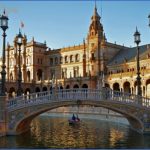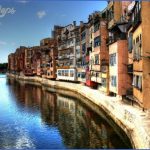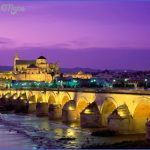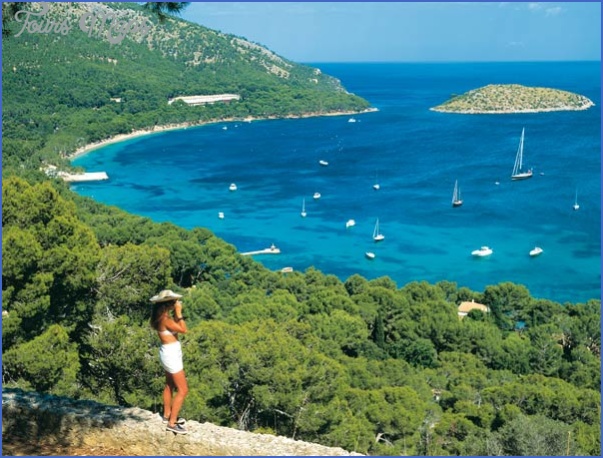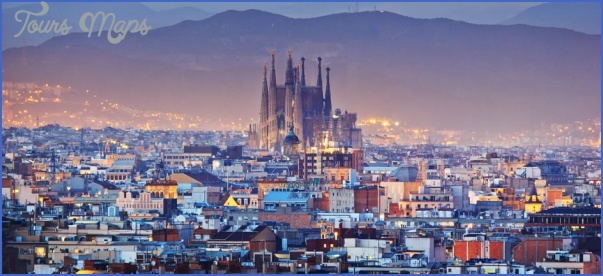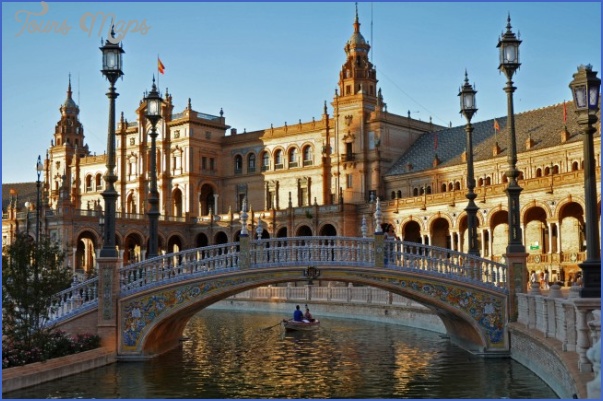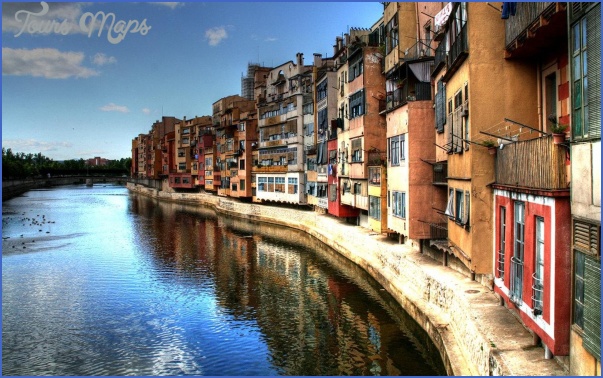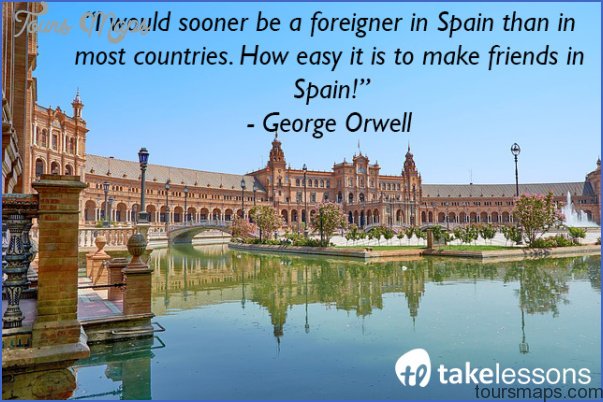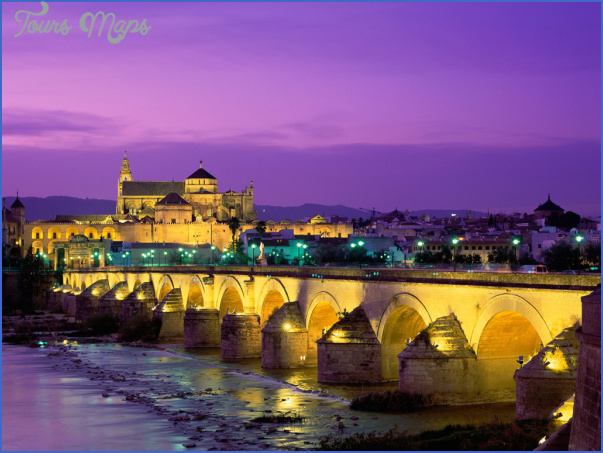Travel to Spain
ARCHITECTURE
Scattered Roman ruins testify to six centuries of colonization. The aqueduct in Segovia (879) is one of the finest examples of remaining ruins. After the invasion of 711, the Moors constructed mosques and palaces throughout southern Spain. Because the Koran forbade representations of humans and animals, architects lavished buildings with stylized geometric designs, red-and-white horseshoe arches, ornate tiles called azulejos, courtyards, pools, and fountains. The spectacular 14th-century Alhambra in Granada (906) and the Mezquita in Cordoba (887) epitomize the Moorish style.
The combination of Islam and Christianity created two architectural movements unique to Spain: Mozarabic and Mudejar. The former describes Christians under Muslim rule (Mozarabs) who adopted Arab devices like the horseshoeshaped arch and the ribbed dome. The more common Mudejar architecture was created by Moors during their occupation. Extensive use of brick and elaborately carved wooden ceilings typify Mudejar style, which reached its height in the 14th century with alcazars (palaces) in Seville (887) and Segovia (879) and synagogues in Toledo (874) and C6rdoba (887).
The first Gothic cathedral in Spain was built in Burgos in 1221, followed closely by cathedral construction in Toledo and Leon. The Spanish Gothic style brought pointed arches, flying buttresses, slender walls, airy spaces, and stained-glass windows. New World riches inspired the Plateresque style, an embellishment of Gothic that transformed wealthier parts of Spain. Intricate stonework and extravagant use of gold and silver splashed 15th- and 16th-century buildings, most notably in Salamanca (881), where the university practically drips with ornamentation. In the late 16th century, Italian Renaissance innovations in perspective and symmetry arrived in Spain to sober up the Plateresque style. El Escorial, Felipe II’s palace, was designed by Juan de Herrera, one of Spain’s most prominent architects, and best exemplifies unadorned Renaissance style (873).
Opulence took over in 17th- and 18th-century Baroque Spain. The Churriguera brothers pioneered this style called, appropriately, Churrigueresque which is equal parts ostentatious, ornamental, and difficult to pronounce. Elaborate works with extensive detail and twisted columns, like the altar of the cathedral in Toledo (874), help distinguish this period in Spanish architecture.
In the late 19th and early 20th centuries, Catalan’s Modernistas burst onto the scene in Barcelona, led by the eccentric genius of Antoni Gaudi, Luis Domenech i Montaner, and Jose Puig i Caldafach. Modemista structures defy previous standards with their voluptuous curves and abnormal textures. Spain’s outstanding architectural tradition continues to this day with such new buildings as the Guggenheim (954) in Bilbao, designed by Santiago Calatrava.
FILM. Franco’s regime (1939-1975) defined Spanish film during and after his rule. Censorship stifled most creative tendencies and left the public with nothing to watch but cheap westerns and bland spy flicks. As government supervision slacked in the early 1970s, Spanish cinema began to show signs of life, led by Carlos Saura’s subversive hits such as The Garden of Delights (1970).
In 1977, when domestic censorship laws were revoked in the wake of Franco’s death, depictions of the exuberant excesses of liberated Spain gained increasing international attention. Pedro Almodovar’s Law of Desire (1986), featuring Antonio Banderas as a homosexual, perhaps best captures the risque themes of transgression most often treated by contemporary Spanish cinema. Almodovar’s All About My Mother won the Best Foreign Film Oscar in 2000. Other influential Spanish directors in Spain include Bigas Luna, director of the controversial Jamon Jamon (1992), and Fernando Trueba, whose Belle Epoque won an Oscar in 1994.
ON THE CANVAS. Residents of the Iberian peninsula were creating art as early as
13,000 BC, the birth date of the fabulous cave paintings at Altamira. In the 11th and 12th centuries AD, fresco painters and manuscript illuminators decorated churches and their libraries along the Camino de Santiago and in Leon (885) and Toledo (874). Pedro Berruguete’s use of traditional gold backgrounds in his religious paintings exemplifies the Italian-influenced style of early Renaissance works. Berruguete’s style is especially evident in his masterpiece, the altarpiece of San Tomas in Avila (1499-1503). Not until after Spain’s imperial ascendancy in the 16th century did painting reach its Golden Age (roughly 1492-1650). Felipe II imported foreign art and artists in order to jump-start native production and embellish his palace, El Escorial. Although he came to Spain seeking a royal commission, El Greco was rejected by Felipe II for his shocking and intensely personal style. Setting up camp in Toledo, El Greco graced the Iglesia de Santo Tome with his masterpiece The Burial of Count Orgaz (1586-1588; 877).
Felipe IV’s foremost court painter, Diego Velazquez, is considered one of the world’s greatest artists. Whether depicting Felipe IV’s family or lowly court jesters and dwarves, Velazquez painted with the same naturalistic precision. Nearly half of this Sevillian artist’s works reside in the Prado, including his famous Las Meninas (Maids of Honor; 1656; 868).
Francisco de Goya, official court painter under the degenerate Carlos IV, ushered European painting into the modern age. Goya’s depictions of the royal family come close to caricature, as Queen Maria Luisa’s cruel jawline in the famous The Family of Charles IV (1800) can attest. Goya’s later paintings graphically protest the lunacy of warfare. The Prado houses an entire room of his chilling Black Paintings (1820-1823; 868).
It is hard to imagine an artist who has had as profound an effect upon 20th-century painting as Andaludan-bom Pablo Picasso. A child prodigy, Picasso headed for Barcelona, which was a breeding ground for Modernist architecture and political activism. Picasso’s Blue Period, beginning in 1900, was characterized by somber depictions of social outcasts. His permanent move to Paris in 1904 initiated his Rose Period, during which he probed the curiously engrossing lives of clowns and acrobats. With his French colleague Georges Braque, he founded Cubism, a method of painting objects simultaneously from multiple perspectives.
Catalan painter and sculptor Joan Miro created simplistic, almost child-like shapes in bright primary colors. His haphazard, undefined creations became a statement against the authoritarian society of Fascist Spain. By contrast, fellow Catalan Salvador Dali scandalized both high society and leftist intellectuals in France and Spain by supporting the Fascists. Dali’s name is virtually synonymous with Surrealism. The painter tapped into dreams and the unconscious for images like the melting clocks in The Persistence of Memory (1931). His haunting Premonition of the Civil War (1936) envisioned war as a distorted monster of putrefying flesh. A shameless self-promoter (he often spoke of himself only in the third person), Dali founded the Teatre-Museo Dali (939) in Figueres, which defines Surrealism in its collection, its construction, and its very existence.
Since Franco’s death in 1975, a new generation of artists, including the unorthodox collage artist Antonio Tapieshas and hyperrealist painter Antonio Lopez Garcia, have thrived. With impressive museums in Madrid, Barcelona, Valencia, Seville, and Bilbao, Spanish artists once again have a national forum for their work.
BULLFIGHTING. The national spectacle that is bullfighting dates, in its modem form, back to the early 1700s. A bullfight is divided into three principal stages: first, picadors (lancers on horseback) pierce the bull’s neck; next, assistants on foot thmst banderillas (decorated darts) into the back; and finally, the torero (bullfighter) performs the kill. If a torero has shown special skill and daring, the audience waves white handkerchiefs to implore the bullfight’s president to reward the coveted ears (and, very rarely, the tail) to the torero. Although bullfighting has always had its critics the Catholic church in the 17th century felt that the risks made it equivalent to suicide the late 20th century has seen an especially strong attack from animal rights’ activists. Whatever its faults, however, bullfighting is an essential element of the Spanish national consciousness.
Travel to Spain Photo Gallery
Maybe You Like Them Too
- Explore Pulau Sebang Malaysia with this Detailed Map
- Explore Southgate, Michigan with this detailed map
- Explore Les Accates, France with this Detailed Map
- Explore Góra Kalwaria, Poland with this detailed map
- Explore Gumdag, Turkmenistan with this detailed map



